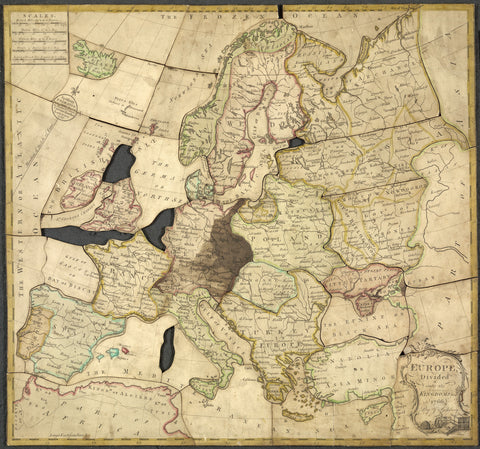The History of the Jigsaw Puzzle
Today, the act of sitting down to put together a puzzle has become a common, shared experience. However, the jigsaw puzzle itself is only a few centuries old. From the first jigsaw puzzle to its modern iterations, we'll be taking you through the exciting history of our favorite pastime.
18th Century — The First “Jigsaw” Puzzle
While several people claim to have created the first "jigsaw” puzzle, most historians give that credit to John Spilsbury, an engraver in England. Around the year 1760, Spilsbury mounted a world map to a sheet of hardwood and used a hand saw to cut around country boundaries. Calling his work "Dissected Maps", he sold them as a tool for teaching geography.
Spilsbury continued his work until he passed in 1769. During his business period, several different manufacturers made note of his modest success and continued production.
Spilsbury produced several different Dissected Maps focusing on areas around the world, such as this map of Europe above.
19th Century — The Birth of the Jig-Saw
The Dissected Maps were popular as educational tools for wealthy families — catching on with even King George III. Hardwoods, such as mahogany, continued as the building material.
While these early puzzles established the practice of adding tabs and blanks, not every piece interlocked. To cut down on build time, most manufacturers only added them to border pieces to establish the frame. Inside pieces were cut along simpler, curved lines.
In the later part of the century, foot-powered jig-saws were invented and put to use in puzzle manufacturing. Though the phrase "jigsaw puzzle" was not in use at this point, we can consider this their full beginning.
Cardboard puzzles also began to appear at this time. However, many manufacturers kept their focus on wood puzzles. In addition to perceptions of low quality, labor costs were similar and so wood puzzles offered higher returns.
20th Century — Popularity and Mass Production
Over the next few decades, larger production houses entered the jigsaw puzzle market. These included Parker Brothers, Milton Bradley, the Detroit Publishing Company, and more. In particular, the Parker Brothers line of wooden Pastime Puzzles is known as one of the most successful series in history. Production of Pastime Puzzles began in 1908 and continued for 50 years.
When the Great Depression hit America, consumption of wood puzzles declined. However, thanks to an innovation in the manufacturing process, puzzle popularity only increased. American companies had developed a new cardboard die-cutting technique. This drastically reduced labor costs and allowed for mass production.
During the Great Depression, cardboard puzzles represented hours of entertainment. The jigsaw could be completed, scrambled, and then passed around within a family or community. More than anything else, they were cheap. So cheap, in fact, that some companies gave them away for free. Cardboard puzzles were used for product promotion, as consumers would be focusing on the image for hours on end.

By the later part of the century, cardboard puzzles had firmly established their dominance in the market. Wood puzzles became a high-end item, produced by a smaller group of manufacturers.
21st Century — Innovation
The standard cardboard puzzle has kept its popularity and remained a part of our culture for over a hundred years. However, innovative companies have always found new ways to delight consumers.
Modern 3D block puzzles offer the ability to create multiple puzzles using the same pieces. Other puzzles provide a different type of challenge, using pieces that can be combined to create many different patterns.


Share this post
- Tags: puzzle accessories, puzzle info
